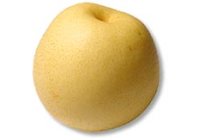Languages
Nashi Pear

The Nashi fruits are nearly round and have flat stem and flower ends. The edible thin skin of the nashi is light green to yellow or bronze; the flesh is light firm and crisp, very juicy with very little seed cells. Because of its mild sweet aroma, the taste reminds of a juicy apple, which gave the fruit the nickname apple pear. The ripeness is discerned by the colour of the skin which changes from green to yellow or rusty red, or both hues simultaneously. Nashis are harvested when fully ripe. Its water content is somewhat higher and the fat content somewhat lower compared to the European pear. The fruit is an excellent diet product.
Today it is mainly cultivated in Japan, but also Korea, China, Taiwan, Australia, New Zealand, Chile, Brazil and the US. For some years now, the nashi has also been grown in Italy, Spain, Portugal and France.
